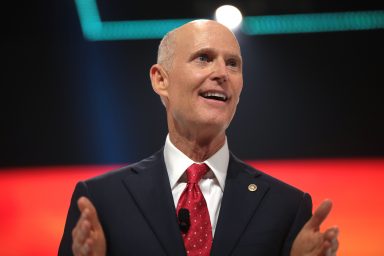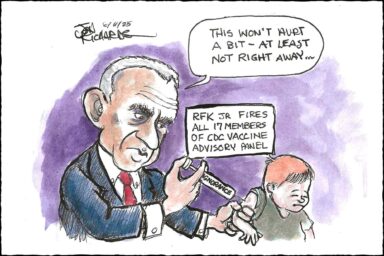Welcome to WhoWhatWhy’s weekly COVID-19 roundup. There’s a lot of virus coverage out there, so this feature will give you a dose of the latest news.
If at first you don’t succeed, mask, mask again.
The takeover of newer, more infectious coronavirus strains has coincided with vaccine rollouts, leaving many torn between hope for a safer future, and fear for the present. While national lockdowns and safety precautions have never truly returned to the intensity of the early days of the pandemic last spring, there’s still something individuals can do to protect themselves: wear a mask. This message has dominated much of coronavirus coverage in the past week.
The Hot Masking Trends of 2021
There are several ways to make your face mask more protective against coronavirus particles, including one which only requires pantyhose. But if you don’t feel like wearing undergarments on your face, there are other options. The South Korean-made KF94 has rocketed to popularity globally as a mask similar in effectiveness to the medical-grade N95s, but intended for public use. Here’s a review of one, but be warned — many are currently sold out online, and there are fakes floating in the market. And, on Wednesday, the CDC announced that double masking (layering a cloth mask over a surgical one) is a simple way to reduce exposure to the virus by more than 90 percent.
Disease and Climate Change
As researchers continue to investigate the animal origins of SARS-CoV-2, a few questions remain especially pertinent: Is environmental degradation somehow a contributing factor to the origin and spread of the virus? Do we expect more disease as a result of climate change? And the question that optimists everywhere love to ask: Is the pandemic creating opportunity for a more environmentally friendly future?
For years, there has been concern over diseases emerging as the earth gets warmer; particularly because melting ice caps contain frozen bacteria, as well as the remains of animals and human victims of the Spanish flu, smallpox, and more. Perhaps climate change also had something to do with the novel coronavirus, a theory which has now been addressed in a study published last Friday.
The study suggests that changes to vegetation and temperature in regions of China, Myanmar, and Laos drove bat species into the southern Chinese Yunnan province. But some experts suggest that this doesn’t necessarily mean that the virus can be linked to climate change. The more likely environmental factor is humans moving into areas with more wildlife, thereby creating more opportunities for disease transmission between people and animals.
Adversity, Meet Opportunity
Whether the disease is caused by climate change or not, they are now clearly interrelated. In many parts of the world, the compounding effects of both COVID-19 and environmental damage have had disastrous results. The policies that the US and other nations have had to implement as a result of COVID-19 signal the possibility of better environmental policy from world leaders. But are the solutions we have for the virus really comparable to the solutions we need for climate change?
The Pfizer and Moderna vaccines are playing a large role in controlling the pandemic, but many warn that confronting global warming will take much more than a “silver bullet” such as these. Multi-faceted solutions are necessary for combating any global crisis. For example, scientists are looking into ways to incentivize small farms to make more sustainable changes to their practices. Researchers say it is not enough to simply introduce innovative technologies; support must be provided so that people are able to take the necessary steps towards change. COVID-19 is the ultimate lesson that we need science, public health, and politics to remain on the same page in order to enact large-scale solutions.
There is evidence that restrictions on travel have slightly reduced carbon emissions. And the really good news is that energy production from coal has been drastically reduced, resulting in lower carbon dioxide emissions globally. This presents an incredible opportunity for the US and other nations to invest in newer and greener technologies. But staying at home doesn’t mean there isn’t an environmental impact; all those virtual conferences and Zoom meetings still require a lot of energy.
Crossover Appeal
The good news continues as collaborations between cancer research and COVID-19 treatment have resulted in promising new methods to cure the virus. The University of California, San Francisco, has announced findings that the drug plitidepsin, normally used to treat multiple myeloma, has been found to be almost 30 times more effective than the current COVID-19 antiviral medication, remdesivir.
Cancer researchers have also been able to use their expertise to solve the mystery of why “COVID brain” happens to some individuals with the disease. This affliction occurs when immune cells make their way into the brain, which also occurs in cancer patients receiving a type of treatment for blood cancer. With this new information, doctors can begin looking for new ways to treat COVID brain. Scientific collaboration wins again.
Related front page panorama photo credit: Adapted by WhoWhatWhy from The White House / Flickr.



